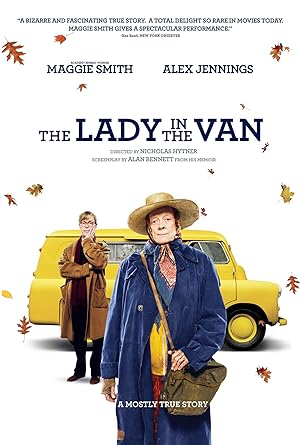The Lady in the Van is set in Camden. Alan Bennett, a playwright, has recently moved into the neighborhood, and he discovers that the neighborhood has unofficially adopted, with reservations, a homeless woman who lives in her van. Bennett takes it a step further and permits her to park her van in his driveway and acts as her unofficial grumbling protector for fifteen years. Bennett is shocked by his response and contrasts it with his treatment of his elderly mom. In a mixture of madness and a stab at retaining her pride, the titular character is not a gracious beneficiary of benevolence, but can be demanding, critical and annoyed by their attention. The Lady in the Van does not impart timeless wisdom and is anything but heartwarming or wise, but forms an odd relationship with her neighbors, which in turn strengthens the community.
The Lady in the Van is primarily told from Bennett’s perspective, and when he talks to himself, the actor pulls a Tom Hardy, but he isn’t a twin. One person is the external Bennett who actually lives in the real world, and the other is the internal Bennett, the writer. In a sense, Bennett lives a life in exile and is trapped within himself despite his attempts to escape the pull of self-reflection. This conceit permits the film to meditate on the nature of the creation of The Lady in the Van as a film by comparing and contrasting the imperfect reality of caring for a smelly, inconsiderate, mentally ill, demanding homeless woman to the temptation to make a Hallmark image of a harmonious mutual relationship that would be more suitable for television. The Lady in the Van showcases how the British are very talented at not glamorizing a story, but telling it in an acerbic tone that somehow still results in a polished, touching finished product.
The Lady in the Van is also told from the titular character’s point of view with occasional traumatic flashbacks. Throughout the movie, the audience gets a sense of her backstory, but it isn’t told linearly or completely until the end. Some of her persona is something borrowed from her tumultuous early relationship with nuns. Her self-condemnation and a self-imposed life in exile are a result of institutional corruption of God’s word and government bureaucracy. Think of a dour Footloose. Even as she lives a life of self-denial of the very thing that could have brought peace to her soul, the color yellow signifies an irrepressible memory of a joyful time before corruption and madness.
My mom loved The Lady in the Van. I enjoyed watching The Lady in the Van, but I left with more questions than answers. Because The Lady in the Van’s narrative is fragmented, self-reflective and time jumps, I possibly got confused and missed pivotal points that answered my questions. How did she pay for more vehicles? Did the writer get the second van? How did she get the car? Instead of rewatching The Lady in the Van, I will read the book.
The Lady in the Van is an utterly charming film and is suitable for all audiences. The Lady in the Van concludes that if you commit to difficult relationships, you may not get a direct benefit from the other person, but you will get a benefit from how that relationship shows you who you are and what you want from another person. This knowledge will create room to leave a life of solitude and enter a life of companionship.
Stay In The Know
Join my mailing list to get updates about recent reviews, upcoming speaking engagements, and film news.





